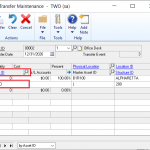Welcome to this years fifth week of Dynamics GP New Feature Blog series, where we will showcase the top features requested by Microsoft customers and partners. Let’s get started!
Feature 16 – Display User ID in Item Master table
Sometimes a change is made on accident, and no one knows who did it. Well now if Bill changes the item description from “Red Phone” to “Green Phone” again, you will know!
The Item Master Table (IV00101) will now have a column (USERID) to track the User ID who last made changes to an Item. For example, if a change is made and saved in the Item Maintenance window, or if a change is rolled down from an Item Class to items, the User ID who executed this action will be listed in this column.
The User ID column is also available to add to the Items SmartList for visibility in the user interface.

Feature 17 – History drop-down defaults to the most recent year
For those of us who have used Microsoft Dynamics GP for 10 plus years, this is a nice feature to have. The history year drop down list will now have the most recent years listed first to help you quickly select your desired year with less scrolling in the following windows:
Net Change Inquiry
Detail Inquiry
Summary Inquiry
Journal Entry Inquiry
Trial Balance Report Options
For Example: To access the Trial Balance Report Options window go to the Reports menu, point to Financial, Click Trial Balance, the Click the New or Modify Button and mark the History Option. Notice how the most recent years are listed first on the top of the drop down list so you don’t have to scroll to find the most recent data.
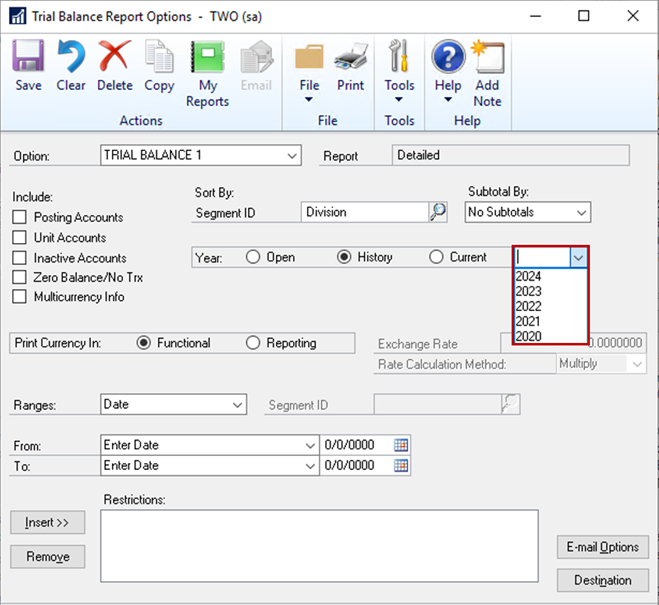
Feature 18 – User Workflow, User Security Workflow, Security Task Workflow, and Security Role Workflow
In Microsoft Dynamics GP, we’ve added four new workflows around users and user security. These new workflows are:
–Security Roles Approval
–Security Task Approval
–User Approval
–User Security Approval
Beginning with the ‘User Security Approval’ workflow, this workflow allows you to require approval when a new or existing user’s security gets added to, modified or deleted from, for a specific company, then have the change submitted to Workflow before committing the change.
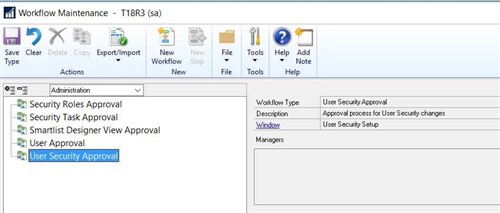
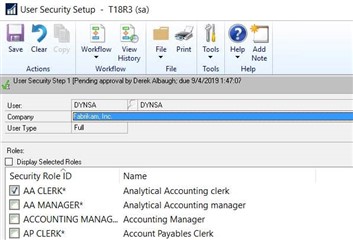
The default email message for the User Security Approval workflow displays information such as the User ID, Company ID, Company Name, Security ModAlt Forms ID and Comments, so the approver(s) can get a quick view of the user security the workflow is pending their approval for.


The next workflow is the User Approval workflow. This workflow allows you to require approval when a new user is created in Microsoft Dynamics GP, and/or an existing user is modified or deleted via the User Setup window. The change is then submitted through Workflow before the change is committed.
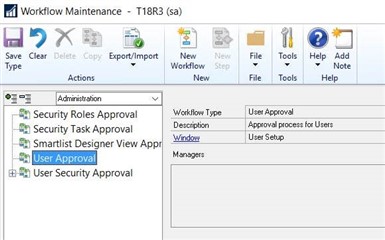

The default email message for the User Approval workflow displays the following information: User ID, User Name, User Type, Status and Class ID as well as Comments.

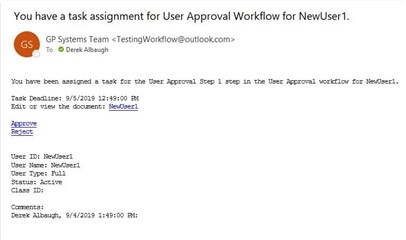
If a user is in the workflow process and someone attempts to give company access via the User Access window, a warning message will show: “You must complete the workflow process for this user before you can continue.” will be displayed and will not be allowed to mark until the user is approved.
If a user opens the ‘Copy user setting’ window then attempts to copy from User ID which is in pending approval status will display a warning message: “You must complete the workflow process for this user before you can continue.” and will clear the user Id field.
The User Approval workflow is applicable for all user types: Full, Limited and Self-Service.
If an existing user is logged in Microsoft Dynamics GP while changes are being made by an Admin for that specific user, they will remain logged in and can continue to log into the company(s) they have access. However, any changes to the user won’t be seen by the user until they log out and back into the GP application
The third new workflow we’ve added to Microsoft Dynamics GP is the Security Roles Approval workflow. This workflow allows you to require approval when a user creates, modifies or deletes a security role, default or custom, within Microsoft Dynamics GP, then have the change submitted to Workflow before the change is committed.

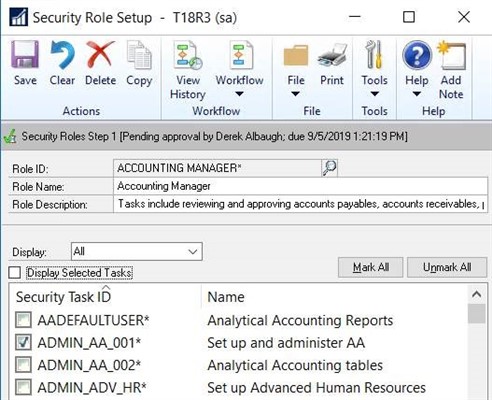
The default email message for the Security Roles Approval workflow displays the following information: Role ID, Role Name, Comments, in order to determine what role is being changed and what is being changed on it, before approving the change.
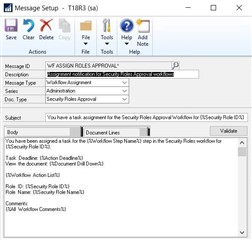
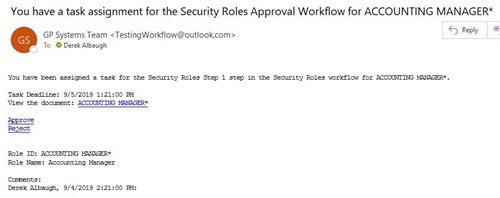
If an existing user is logged into Microsoft Dynamics GP while changes are being made by an admin for that specific user’s security, they will remain logged into the company(s) with the same security permissions. However, any changes to the user’s security won’t be seen by the user until they log out and back into the GP application.
If a security role that is in the Workflow process is assigned to a user’s security, the following message will show when it is marked: “The selected Security Role ID is in a workflow process so it can’t be assigned.” The task will remain un-marked.
Along the same lines, the last workflow we’ve added to Microsoft Dynamics GP is the Security Task Approval workflow, where you can require approval when a user creates, modifies or attempts to delete a custom or default security task within the application, then have those changes submitted into Workflow before committing the changes.


The default email message for this Security Task Approval workflow displays the following information: Task ID, Task Name, Task Description, Task Category and Comments, so that approvers can look at the specific security task before approving any changes being made to it.
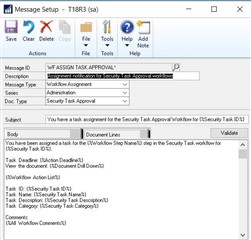
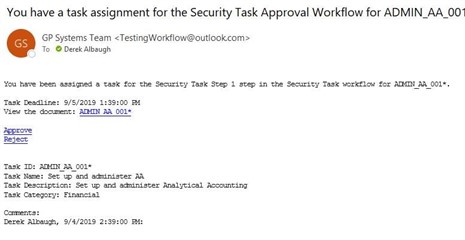
Again, if an existing user is logged in Microsoft Dynamics GP while changes are being made by an Admin for that specific user’s security, they will remain logged into the company(s) with the same security permissions. However, any changes to the user’s security won’t be seen by the user until they log out and back into the GP application.
If a security task that is in the workflow process is assigned to a security role, the following message will show when it is marked: “The selected Security Task ID is in a workflow process so it can’t be assigned.” The task will remain un-marked.
Feature 19 – Import and Export Workflow
In Microsoft Dynamics GP, we’ve added the ability to import and export Workflow types, in order to copy an existing workflow setup from one company database to another.
When the workflow is exported out, then imported into another company database, it will import all of the setup of the workflow type, including all steps and conditions, all you then need to do is add approvers into the imported workflows, as those are not imported along, as the approvers are most likely not going to be the same company to company.
The workflow steps imported have the exact same name, though you can change the name of the workflow being imported during that process.
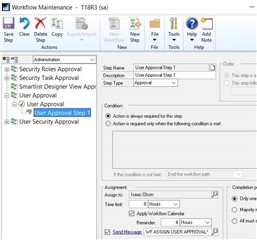
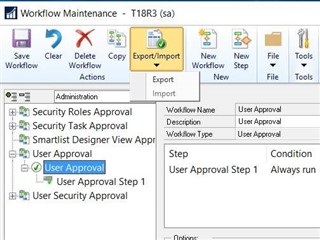
In this example, I have a new ‘User Approval’ workflow type, named ‘User Approval’ and this workflow has one approval step setup, named ‘User Approval Step 1’.
Clicking the ‘Export’ option under the Export/Import menu in the Workflow Maintenance window, it opens the following Export/Import Workflow window:

The exported workflow information is put into a .JSON file type at the location and file name you specify.
On a completely separate instance of Microsoft Dynamics GP and/or company database, clicking the ‘Import’ option under the ‘Export/Import’ menu in the Workflow Maintenance window again, it opens the same Export/Import Workflow window, where you can browse to the .JSON file exported out for the existing workflow type, such as the User Approval workflow exported out above.
During the import process, you can give the workflow a new name or keep the same name, then click ‘Import’, to bring the exported workflow type into the Workflow Maintenance window, so you can set it up and modify as you need.
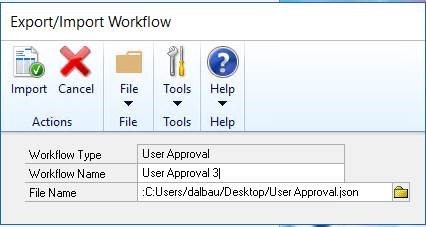
The import process will mention that you need to assign approvers to the workflow step(s) that were brought into the application.


You will also need to re-mark the option to ‘Send Message’ on imported workflows, if you want email notifications to be sent out to approvers per the workflow steps.
This new feature will allow customers to copy workflows between company databases in the same Microsoft Dynamics GP instance, and also completely separate Microsoft Dynamics GP instances, so customer, partners and hosting providers can setup a workflow the way they want, get it working correctly, then export it and import it onto GP environments for more than one customer or company database as needed.
And that wraps it up for this years week 5 of Microsoft GP New Feature blog series. For more information/documentation on new features please check out Microsoft Dynamics GP New Feature Blog Series!
Contact us to learn more about our commitment to help customers implement their financial and business management systems. Team up with a certified, Microsoft Gold Partner to make your migration to the cloud seamless. Or if you have any questions regarding Dynamics 365 or other ERP/CRM systems, you can contact us here.
Don’t forget to follow us on Facebook, LinkedIn, and Twitter. Subscribe to our YouTube channel for insightful tutorials and demos.





